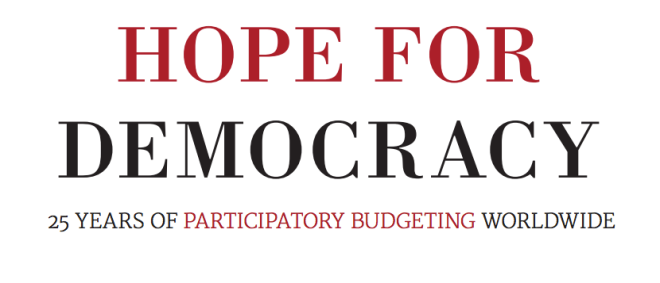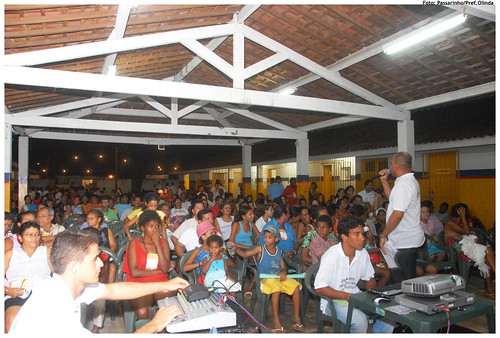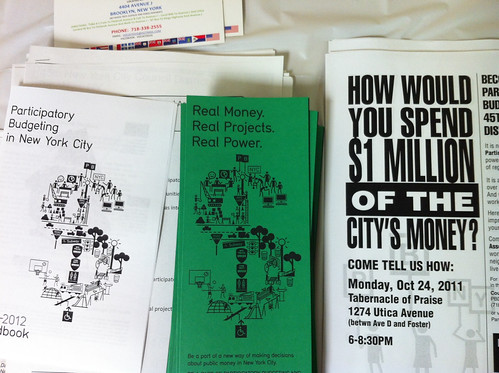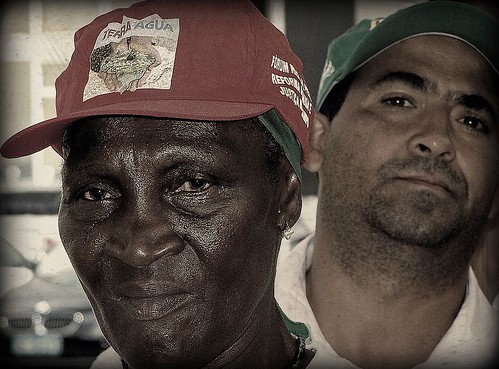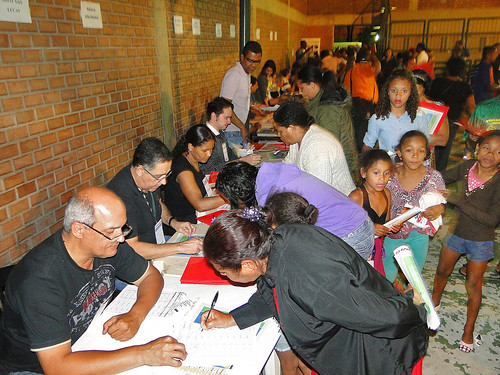
The Journal of Field Actions, together with Civicus, has just published a special issue “Stories of Innovative Democracy at the Local Level: Enhancing Participation, Activism and Social Change Across the World.” When put together, the 13 articles provide a lively illustration of the wealth of democratic innovations taking place around the world.
Category Archives: Participatory Budgeting
Technology and Citizen Engagement: Friend or Foe?
Within the open government debate, there is growing interest in the role of technology in citizen engagement. However, as interest in the subject grows, so does the superficiality of the conversations that follow. While the number of citizen engagement and technology events is increasing, the opportunities for in-depth conversations on the subject do not seem to be increasing at the same rate.
This is why, a few weeks ago, I was pleased to visit the University of Westminster for a kick-off talk on “Technology and Participation: Friend or Foe?”, organized by Involve and the Centre for the Study of Democracy (Westminster). It was a pleasure to start a conversation with a group that was willing to engage in a longer and more detailed conversation on the subject.
My talk covered a number of issues that have been keeping me busy recently. On the preliminary quantitative work that I presented, credit should also go to the awesome team that I am working with, which includes Fredrik Sjoberg (NYU), Jonathan Mellon (Oxford) and Paolo Spada (UBC / Harvard). For those who would like to see some of the graphs better, I have also added here [PDF] the slides of my presentation.
I have skipped the video to the beginning of my talk, but the discussion that followed is what made the event interesting. In my opinion, the contributions of Maria Nyberg (Head of Open Policy Making at the Cabinet Office) Catherine Howe (Public-i), as well as those of the participants, were a breath of fresh air in the current citizen engagement conversation. So please bear with me and watch until the end.
I would like to thank Simon Burral (Involve) and Graham Smith (Westminster) for their invitation. Simon leads the great work being done at Involve, one of the best organizations working on citizen engagement nowadays. And to keep it short, Graham is the leading thinker when the issue is democratic innovations.
Below is also an excellent summary by Sonia Bussu (Involve), capturing some of the main points of my talk and the discussion that ensued (originally posted here).
***
“On technology and democracy
The title of yesterday’s event, organised by Involve and Westminster University’s Centre for the Study of Democracy, posed a big question, which inevitably led to several other big questions, as the discussion among a lively audience of practitioners, academics and policymakers unfolded (offline and online).
Tiago Peixoto, from the World Bank, kicked off the debate and immediately put the enthusiasm for new technologies into perspective. Back in 1795, the very first model of the telegraph, the Napoleonic semaphore, raised hopes for – and fears of – greater citizen engagement in government. Similarly the invention of the TV sparked debates on whether technology would strengthen or weaken democracy, increasing citizen awareness or creating more opportunities for market and government manipulation of public opinion.
Throughout history, technological developments have marked societal changes, but has technological innovation translated into better democracy? What makes us excited today about technology and participation is the idea that by lowering the transaction costs we can increase people’s incentives to participate. Tiago argued that this costs-benefits rationale doesn’t explain why people continue to vote, since the odds of their vote making a difference are infinitesimal (to be fair voter turnouts are decreasing across most advanced democracies – although this is more a consequence of people’s increasing cynicism towards political elites rather than their understanding of mathematical probabilities).*
So do new technologies mobilise more people or simply normalise the participation of those that already participate? The findings on the matter are still conflicting. Tiago showed us some data on online voting in Rio Grande do Sul participatory budgeting process in Brazil, whereby e-voting would seem to bring in new voters (supporting the mobilisation hypothesis) but from the same social strata (e.g. higher income and education – as per the normalisation hypothesis).
In short, we’re still pretty much confused about the impact of technology on democracy and participation. Perhaps, as suggested by Tiago and Catherine Howe from Public-i, the problem is that we’re focusing too much on technology, tempted by the illusion it offers to simplify and make democracy easy. But the real issue lies elsewhere, in understanding people and policymakers’ incentives and the articulation (or lack thereof) between technologies and democratic institutions. As emphasised by Catherine, technology without democratic evolution is like “lipstick on a pig”.
The gap between institutions and technology is still a big obstacle. Catherine reminded us how participation often continues to translate into one-way communication in government’s engagement strategies, which constrains the potential of new technologies in facilitating greater interaction between citizens and institutions and coproduction of policies as a response to increasing complexity. As academics and practitioners pitch the benefits of meaningful participation to policy makers, Tiago asked whether a focus on instrumental incentives might help us move forward. Rather than always pointing to the normative argument of deepening democracy, we could start using data from cases of participatory budgeting to show how greater participation reduces tax evasion and corruption as well as infant mortality.
He also made a methodological point: we might need to start using more effectively the vast array of data on existing engagement platforms to understand incentives to participation and people’s motivation. We might get some surprises, as findings demystify old myths. Data from Fix My Street would seem to prove that government response to issues raised doesn’t increase the likelihood of future participation by as much as we would assume (28%).** But this is probably a more complicated story, and as pointed out by some people in the audience the nature and salience of both the issue and the response will make a crucial difference.
Catherine highlighted one key problem: when we talk about technology, we continue to get stuck on the application layer, but we really need to be looking at the architecture layer. A democratic push for government legislation over the architecture layer is crucial for preserving the Internet as a neutral space where deeper democracy can develop. Data is a big part of the architecture and there is little democratic control over it. An understanding of a virtual identity model that can help us protect and control our data is key for a genuinely democratic Internet.
Maria Nyberg, from the Cabinet Office, was very clear that technology is neither friend nor foe: like everything, it really depends on how we use it. Technology is all around us and can’t be peripheral to policy making. It offers great opportunities to civil servants as they can tap into data and resources they didn’t have access to before. There is a recognition from government that it doesn’t have the monopoly on solutions and doesn’t always know best. The call is for more open policy making, engaging in a more creative and collaborative manner. Technology can allow for better and faster engagement with people, but there is no silver bullet.
Some people in the audience felt that the drive for online democracy should be citizen-led, as the internet could become the equivalent of a “bloodless guillotine” for politicians. But without net neutrality and citizen control over our own data there might be little space for genuine participation.
*This point was edited on 12/07/2014 following a conversation with Tiago.
** This point was edited on 12/07/2014 following a conversation with Tiago.”
—————————
I am also thankful to the UK Political Studies Association (PSA), Involve and the University of Westminster for co-sponsoring my travel to the UK. I will write more later on about the Scaling and Innovation Conference organized by the PSA, where I was honored to be one of the keynote speakers along with MP Chi Onwurah (Shadow Cabinet Office Minister) and Professor Stephen Coleman (Leeds).
New Book on 25 Years of Participatory Budgeting
A little while ago I mentioned the launch of the Portuguese version of the book organized by Nelson Dias, “Hope for Democracy: 25 Years of Participatory Budgeting Worldwide”.
The good news is that the English version is finally out. Here’s an excerpt from the introduction:
This book represents the effort of more than forty authors and many other direct and indirect contributions that spread across different continents seek to provide an overview on the Participatory Budgeting (PB) in the World. They do so from different backgrounds. Some are researchers, others are consultants, and others are activists connected to several groups and social movements. The texts reflect this diversity of approaches and perspectives well, and we do not try to influence that.
(….)
The pages that follow are an invitation to a fascinating journey on the path of democratic innovation in very diverse cultural, political, social and administrative settings. From North America to Asia, Oceania to Europe, from Latin America to Africa, the reader will find many reasons to closely follow the proposals of the different authors.
The book can be downloaded here [PDF]. I had the pleasure of being one of the book’s contributors, co-authoring an article with Rafael Sampaio on the use of ICT in PB processes: “Electronic Participatory Budgeting: False Dilemmas and True Complexities” [PDF].
While my perception may be biased, I believe this book will be a major contribution for researchers and practitioners in the field of participatory budgeting and citizen engagement in general. Congratulations to Nelson Dias and all the others who contributed their time and energy.
A Review of the Evidence on Open Budgeting
Brand new.
“A Review of the Evidence on Open Budgeting” is a recent report by the World Bank Institute’sCapacity Development and Results team. It explores key questions and existing evidence around the impact of open budgeting. Despite the growing body of literature, there remains limited substantiation for whether and how open budgeting contributes to reductions in poverty and improvements in the lives of the poor. This report pieces together the results chain presenting evidence for and against from the literature. It explores links between open budgeting and indicators of impact such as human development and public service delivery. The findings highlight the importance of measuring budget transparency, accountability, and participation. The findings show that the impact of institutional changes differ under varying conditions in specific contexts. The conclusions of the report point to the need for further investigation into impact and establishing effective measurement practices for monitoring related institutional change under varying conditions and different contexts.”
You can download the report here [PDF].
When Citizen Engagement Saves Lives (and what we can learn from it)
When it comes to the relationship between participatory institutions and development outcomes, participatory budgeting stands out as one of the best examples out there. For instance, in a paper recently published in World Development, Sonia Gonçalves finds that municipalities that adopted participatory budgeting in Brazil “favoured an allocation of public expenditures that closely matched the popular preferences and channeled a larger fraction of their total budget to key investments in sanitation and health services.” As a consequence, the author also finds that this change in the allocation of public expenditures “is associated with a pronounced reduction in the infant mortality rates for municipalities which adopted participatory budgeting.”
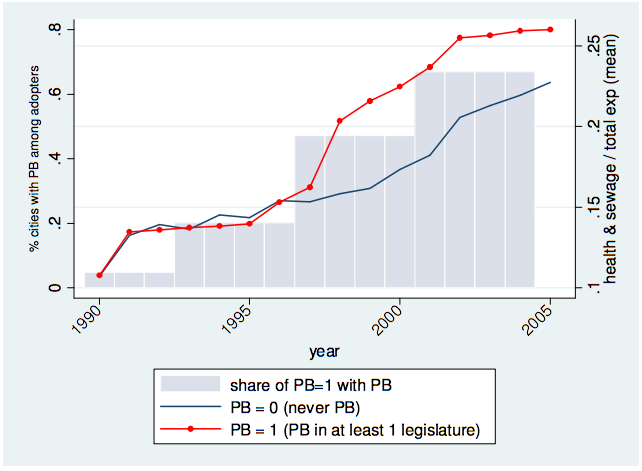
Evolution of the share of expenditures in health and sanitation compared between adopters and non-adopters of participatory budgeting (Goncalves 2013).
Now, in an excellent new article published in Comparative Political Studies, the authors Michael Touchton and Brian Wampler come up with similar findings (abstract):
We evaluate the role of a new type of democratic institution, participatory budgeting (PB), for improving citizens’ well-being. Participatory institutions are said to enhance governance, citizens’ empowerment, and the quality of democracy, creating a virtuous cycle to improve the poor’s well-being. Drawing from an original database of Brazil’s largest cities over the last 20 years, we assess whether adopting PB programs influences several indicators of well-being inputs, processes, and outcomes. We find PB programs are strongly associated with increases in health care spending, increases in civil society organizations, and decreases in infant mortality rates. This connection strengthens dramatically as PB programs remain in place over longer time frames. Furthermore, PB’s connection to well-being strengthens in the hand of mayors from the nationally powerful, ideologically and electorally motivated Workers’ Party. Our argument directly addresses debates on democracy and well-being and has powerful implications for participation, governance, and economic development.
When put together, these findings provide compelling evidence for those who – often unfamiliar with the literature – question the effectiveness of participatory governance institutions. Surely, more research is needed, and different citizen engagement initiatives (and contexts) may lead to different results.
But these articles also bring another important takeaway for those working with development and public sector reform. And that is the need to consider the fact that participatory institutions (as most institutional reforms) may take time to produce desirable/noticeable effects. As noted by Touchton and Wampler:
The relationships we describe between PB and health and sanitation spending, PB and CSOs, and PB and health care outcomes in this section are greater in magnitude and stronger in statistical significance for municipalities that have used PB for a longer period of time. Municipalities using PB for less than 4 years do exhibit lower infant mortality rates than municipalities that never adopted PB. However, there is no statistically significant difference in spending on health care and sanitation between municipalities using PB for less than 4 years and municipalities that never adopted the program. This demonstrates the benefits from adopting PB are not related to low-hanging fruit, but built over a great number of years. Our results imply PB is associated with long-term institutional and political change—not just short-term shifts in funding priorities .
If throughout the years participatory budgeting has produced evidence of its effectiveness on a number of fronts (e.g. pro-poor spending), it is only 25 years after its first implementation in Brazil that we start to see systematic evidence of sound development outcomes such as reduction in infant mortality. In other words, rushing to draw conclusions at early stages of participatory governance interventions may result in misleading assessments. Even worse, it may lead to discontinuing efforts that are yet to bear fruit in the medium and longer terms.
10 Most Read Posts in 2013
Below is a selection of the 10 most read posts at DemocracySpot in 2013. Thanks to all of those who stopped by throughout the year, and happy 2014.
1. Does transparency lead to trust? Some evidence on the subject.
2. The Foundations of Motivation for Citizen Engagement
3. Open Government, Feedback Loops, and Semantic Extravaganza
4. Open Government and Democracy
5. What’s Wrong with e-Petitions and How to Fix them
6. Lawrence Lessig on Sortition and Citizen Participation
7. Unequal Participation: Open Government’s Unresolved Dilemma
8. The Effect of SMS on Participation: Evidence from Uganda
9. The Uncertain Relationship Between Open Data and Accountability
10. Lisbon Revisited: Notes on Participation
Documentary: Participatory Budgeting in Belo Horizonte
Through the Facebook Participatory Budgeting group I came across a documentary about Belo Horizonte’s PB. The documentary, by Joao Ramos de Almeida, provides a unique view of the functioning of one of the oldest PBs in Brazil.
Among other things, the documentary shows how the process leads to a degree of civic empowerment and activism rarely seen in traditional governing models. It is particularly interesting to see how citizens contest, for instance, the cost estimates of public works made by the city administration. The documentary also shows how PB manages to engage citizens in an extremely time consuming process. It is also interesting to see that, while there is some degree of deliberation in the PB process, much of it is also about negotiation between the different communities involved.
Among other things, it shows that Belo Horizonte’s PB is far from perfect, and the suspicion of some degree of co-optation of some PB participants by the administration highlights difficulties that are inherent to many participatory processes. To some, it might come across as a sobering message. Yet, when looking at participatory initiatives, we should not only compare their functioning to an ideal vision of democracy. In this case, we should also compare it to the status quo, that is, how public budgeting takes place in the absence of public participation.
For those interested in citizen engagement this documentary (English subtitles, 55 mins) is worth watching.
***
Also read
Participatory Budgeting and Digital Democracy: the Belo Horizonte Case
The Effects of Participatory Budgeting on Infant Mortality in Brazil
Participatory Budgeting: Seven Defining Characteristics
Participatory Budgeting and Technology: Innovations in Open Government
The Participatory Turn: Participatory Budgeting Comes to America
The Participatory Turn: Participatory Budgeting Comes to America
So here it is, finally, the much awaited PhD by Hollie Russon-Gilman (Ash Center – Harvard) on Participatory Budgeting in the United States.
Below is the abstract.
Participatory Budgeting (PB) has expanded to over 1,500 municipalities worldwide since
its inception in Porto Alege, Brazil in 1989 by the leftist Partido dos Trabalhadores
(Workers’ Party). While PB has been adopted throughout the world, it has yet to take
hold in the United States. This dissertation examines the introduction of PB to the United
States with the first project in Chicago in 2009, and proceeds with an in-depth case study
of the largest implementation of PB in the United States: Participatory Budgeting in New
York City. I assess the outputs of PB in the United States including deliberations,
governance, and participation.
I argue that PB produces better outcomes than the status quo budget process in New York
City, while also transforming how those who participate understand themselves as
citizens, constituents, Council members, civil society leaders and community
stakeholders. However, there are serious challenges to participation, including high costs
of engagement, process exhaustion, and perils of scalability. I devise a framework for
assessment called “citizenly politics,” focusing on: 1) designing participation 2)
deliberation 3) participation and 4) potential for institutionalization. I argue that while the
material results PB produces are relatively modest, including more innovative projects,
PB delivers more substantial non-material or existential results. Existential citizenly
rewards include: greater civic knowledge, strengthened relationships with elected
officials, and greater community inclusion. Overall, PB provides a viable and
informative democratic innovation for strengthening civic engagement within the United
States that can be streamlined and adopted to scale.
You can read the full dissertation here [PDF].
Like it? You might also want to read this about who participates in NYC’s PB and this about the effects of PB on infant mortality in Brazil.
Civil Society and Participation in Brazil: A Literature Review
This literature review is divided into six sections. The first section briefly describes the theoretical and empirical background of debates about civil society and participation: the democratization process of the 1980s. The second section examines the first and second generation of studies of the best-known participatory mechanism in Brazil – participatory budgeting (PB). Next, this review turns attention toward research on policy councils, which fuelled more theoretical advances than studies of PB. A short section presents the few available studies about participation in the Northeast region of Brazil – a still largely unchartered territory in the literature. The fifth section discusses normative debates about the meaning and purpose of participation. Although the debate is not as contentious as it was in the early-2000s, two distinct views about participation still mark this literature. The last and longest section analyzes studies that treat citizen participation as a constitutive part of the representative system, which can help to improve government accountability and increase the quality of democracy.
Read full paper here [PDF].


